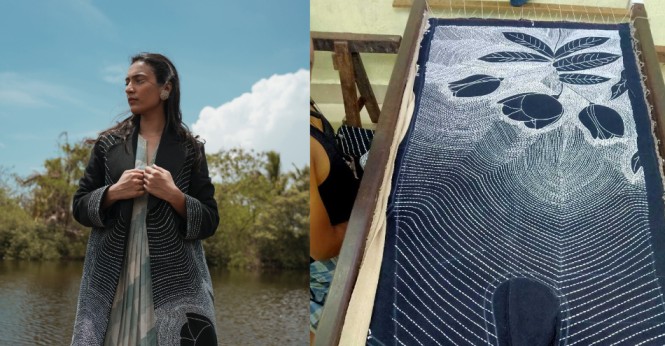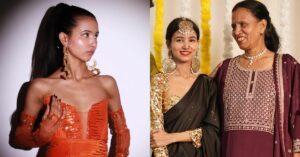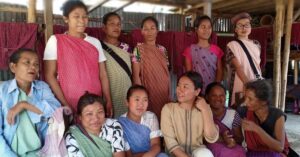22-YO Turns Plastic Waste into Traditional Embroidery, Showcases at Lakme Fashion Week
Design student Sara Lakhani launched Trash or Treasure to turn plastic into ethnic wear using kantha embroidery. Her initiative won her an opportunity to showcase her work at Lakme Fashion Week.

At home or on the streets, everywhere you turn, you are more than likely to find plastic in its various forms. The material is such a deep rooted part of human experience that eliminating even single-use plastic feels like a difficult task.
Even while single-use plastic is banned in 25 states in India, we continue to produce 34,69,780 tonnes of plastic as per a Central Pollution Control Board (CPCP) report. This figure is likely to be more than double in five years. The same report states that Maharashtra and Tamil Nadu are the highest contributors of plastic waste generation.
Out of this 3.5 million tonnes of plastic, only 50 percent is recycled, suggests a Livemint report.
But Gadchiroli-born Sara Lakhani is on a mission to use this waste in a way that lengthens its journey to the landfills and dump yard. Through her clothing line Trash or Treasure, the 22-year-old design student uses waste polythene bags to make threads, which are in turn used to make intricate Kantha embroidery.
More than 200 polythene bags were used to bring the collection to life.
On October 16 this year, she got the opportunity to showcase her collection at Lakme Fashion.
“As the saying goes, one man’s trash is another man’s treasure, I wanted to create something that would look good and be sustainable,” Sara tells The Better India.

Combining traditions with modern sustainability
“Growing up in a small town amid nature, I was always driven towards trees and natural beauty. My family had a pharmacy business and I would see plastic waste piling up everywhere. My father would burn the waste, which was very bad for the environment, but in small towns there are no proper ways of disposing of plastic waste and people do not have a lot of options,” she recalls.
So when it came to designing her own line of clothing, she instantly knew where to look. “When I started off with the project, I knew very well that whatever designs I make have to use sustainable materials,” she adds.
“In the initial days, I knew very little about the kind of plastics that are produced, what could be used and could not be for clothing. As a design student, I had to keep in mind that the designs need to be appealing to the eye and also comfortable to wear,” she says.
Sara started researching various ways of using plastic to turn into thread and yarn, while simultaneously experimenting with different embroidery techniques. “I realised that Kantha embroidery would use the maximum amount of plastic in comparison to other embroideries and was intricate and beautiful to look at, so I chose that form,” she says.
Kantha is considered one of the oldest forms of embroidery. It is patchwork made with rags and originated in the Bengal region, later spreading to Tripura and Odisha. The design is formed by making simple straight stitches with a complex geometric pattern on the front and a running stitch at the back of the fabric.
Although there are no set designs, the embroidery usually consists of patterns of leaves, birds, lotus, etc.
“The biggest challenge was that since the embroidery is intricate, the thread made from plastic was not strong enough to hold the stitch together. Going to and fro, I realised that cutting out wider strips of plastic and then making them into threads was helping in holding the stitch together,” she says.
Sara then went on to find embroiderers who would help her make her pieces.
“I found one embroiderer in Bandra who decided to help me. Initially he was very sceptic, because the plastic threads were more delicate and needed more time too. I would spend hours in his karkhana (workshop) working on pieces with him. One piece would need at least 15 days of manpower and extreme delicate hand work,” she says.
Every inch and every stitch breathes sustainability
Sara wanted her collection to be as sustainable and upcycled as possible. To do so, she contacted various NGOs that could help her acquire upcycled fabrics and plastic bags.
“I found a NGO called 5R cycle that would collect plastic from different landfills, segregate it, and then recycle it. I took their help to procure plastic bags. The thing with the fashion industry is that people would want something that looks good, so I approached them and asked them to give me different colours of plastic. They were extremely helpful,” she says.
Sara says the fabric she used in her garments was also upcycled.
“I wanted to make my garments as eco-friendly as I could. All the materials used are upcycled. Another NGO called Khaloom in Mumbai helped me with the fabrics. They collect waste clothes from landfills and waste yards, convert them again into yarn, and weave them again into fabrics,” she explains.
With this process, Trash or Treasure makes corsets, tops, skirts, dresses and outer jackets. Sara sells her products through her Instagram (@the.pinkrhino).
The road ahead
Being at the starting point of her career, Sara says she wants to learn more about how the industry works and how she can make things more sustainable.
“Lakme Fashion week was a delight, I was the only one from my campus who received the opportunity. My generation understands how important it is to be more sustainable, and how our activities cause damage to the environment. We know there is a problem and we want to look for newer solutions. The design industry has a big horizon, I know there are more things to play around with and I wish to explore more and make clothing in India sustainable and eco friendly,” she says. If you found our stories insightful, informative, or even just enjoyable, we invite you to consider making a voluntary payment to support the work we do at The Better India. Your contribution helps us continue producing quality content that educates, inspires, and drives positive change. Choose one of the payment options below for your contribution- By paying for the stories you value, you directly contribute to sustaining our efforts focused on making a difference in the world. Together, let’s ensure that impactful stories continue to be told and shared, enriching lives and communities alike. Thank you for your support. Here are some frequently asked questions you might find helpful to know why you are contributing?

Edited by Divya Sethu
This story made me
-
97
-
121
-
89
-
167













